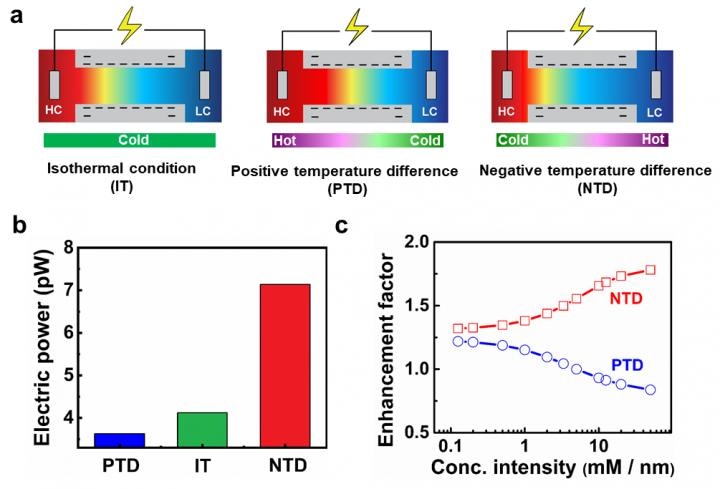Aug 7 2019
Although salinity gradient energy serves as an excellent candidate for the substitution of the conventional fossil fuels, concerns about nanofluidic salinity gradient energy harvesting through membranes or ion channels have recently been growing due to the developments in materials science and nanotechnology.
 (a) Schematic illustration of the ion concentration profiles with asymmetric transmembrane temperature differences. (b) Electric power under different temperature differences. (c) At small transmembrane concentration intensities, both positive and negative temperature differences contribute to the electric power. At high transmembrane concentration intensities, a negative temperature difference promotes power extraction and a positive temperature difference hinders the electric power. (Image credit: Science China Press)
(a) Schematic illustration of the ion concentration profiles with asymmetric transmembrane temperature differences. (b) Electric power under different temperature differences. (c) At small transmembrane concentration intensities, both positive and negative temperature differences contribute to the electric power. At high transmembrane concentration intensities, a negative temperature difference promotes power extraction and a positive temperature difference hinders the electric power. (Image credit: Science China Press)
As salinity gradient energy can provide much higher power density compared to the macro reverse electrodialysis systems, it has the ability to collect the blue energy (approximately 1.4–2.6 TW) emitted when seawater and river water combine and to increase the energy extracted for membrane-based osmotic heat engines.
Scientists have previously attempted to concentrate on the nanofluidic energy conversion system mostly under isothermal conditions. Traditional perspective proposes that a high temperature and a long channel length that ensure a high effective concentration difference and a large selectivity are required to enhance the membrane potential.
This instinctive understanding explains that increasing temperature helps to realize better performance. The transmembrane temperature difference, however, is a very crucial, yet long-disregarded, factor that affects the performance of the nanofluidic devices.
In a new study reported in National Science Review, a Beijing-based journal, researchers from Huazhong University of Science and Technology, China, have shown that nanofluidic energy production is unusually dependent on temperature.
A negative temperature difference could notably increase the membrane potential owing to the effect of ionic thermal up-diffusion that advances the selectivity and inhibits the polarization of ion concentration, particularly at the lower concentration side, causing markedly increased electrical energy.
Simple and cost-effective methods have also been suggested to produce tunable ionic voltage sources and improve salinity gradient energy conversion depending on mimetic nanochannels and small nanoscale biochannels.
Scientifically, we reveal the importance of a long-overlooked element, transmembrane temperature difference, in nanofluidic salinity gradient energy harvesting. For applications and guidance, we can fabricate tunable ionic voltage sources, where the voltage is tuned by the temperature at the low concentration side and the internal resistance adjusted by the temperature at the high concentration side.
Prof. Wei Liu, Huazhong University of Science and Technology, China
Prof. Liu continued, “And waste heat can be employed to enhance the power output and ionic flux by establishing transmembrane temperature difference to match the optimal transmembrane concentration intensity under the nanoscale biochannels and mimetic nanochannels.”
This study was financially supported by the National Natural Science Foundation of China.